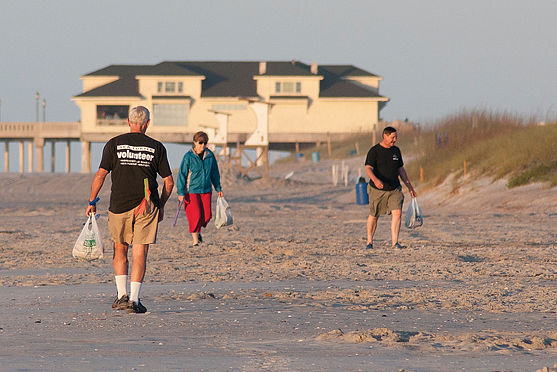The sun began to peek above the horizon at 6:30 a.m. when the strand was quiet and still. Two people walked along the tideline, one carrying a plastic bag of trash.
The pair was mother and son, Kim and Patrick Shovlin, Wrightsville Beach Sea Turtle Project volunteers, who have been volunteering for about five years.
“I got started because of him,” said Kim as she pointed to her 15-year-old son, Patrick, whose interest in sea turtles led him to the organization.
Kim said it was a great way to bond with her son while volunteering their time for a greater cause.
“Every zone [of the beach] is covered seven days a week by volunteers,” Kim said. “We get out here at sunrise and walk along the tide lines. We’re looking for tracks.”
Because sea turtles nest at night, volunteers monitor the beach at dawn for turtle tracks, a visible sign that a female turtle has crawled ashore to lay her eggs. The nest is then located and roped off as part of the project’s mission.
“[Wrightsville Beach Sea Turtle Project] was founded to locate and provide protection to sea turtle nests found on the beach,” said Nancy Fahey, project coordinator.
Beginning in May, female sea turtles lay their eggs on North Carolina beaches. Each nest, known as a clutch, contains approximately 120 eggs. Immediately after laying her eggs, the mother turtle crawls back to the ocean, never to be seen again by her offspring. Incubation takes about 60 days, thus leaving the eggs exposed to potential dangers on the beach.
“Sometimes the mommy turtle decides to [nest] in a place that’s not very conducive to beach traffic. So we have to relocate it,” Kim said. “Last year, we had one right on the path where the emergency vehicles go, so it could potentially get run over.”
In a case such as this, the nest is relocated to a safer spot with extreme caution and precision; a nest chamber of identical depth and width is dug, and the eggs are replaced in the same order.
“Every morning, we check on the nests to make sure no one has disturbed the eggs,” Kim said.
Recently, the dredging process on Wrightsville Beach worried the volunteers.
“It’s hard to differentiate … vehicle from turtle tracks,” Patrick said.
Due to the dredging process, heavy machinery is used. These tools have the potential to harm sea turtle eggs. But two volunteers were present every night during the renourishment process to ensure that no sea turtles nested in the work area, or crawled into the sand-pumping pipe.
“We’re there from 8 p.m. to 6 a.m., so there’s not a lot of sleeping,” Fahey said. “One of us has to stay at the construction site while the other monitors that pipeline looking for those tracks. Now they’re removing the pipes,” Fahey said about the end of the dredging. “And again we’ll have to be there because of the heavy machinery.”
After setting it down on the beach, Kim opened the plastic bag. It was full of broken beach toys, a leftover watermelon shell and an agitator from a washing machine.
“We always try to pick up trash when we see it,” Kim said.
The loggerhead sea turtle, which most commonly nests in North Carolina, is known to frequently ingest plastic, which contributes to its status as an endangered species. The National Marine Life Center states 86 percent of sea turtles are entangled in or ingest plastic, or both.
The trash collected by the volunteers is counted by Bonnie Monteleone, University of North Carolina Wilmington Debris Research and Lab Assistant; and Ginger Taylor, who manages Wrightsville Beach — Keep It Clean, a volunteer litter pick-up program.
“The biggest problem with plastic debris is the fact that we are looking at plastic as trash and not seeing its value,” Monteleone said. “If we give plastic value, and we should because it is made out of natural gas and petroleum, it won’t end up where it doesn’t belong. We need to start seeing it as building material, or at the very least as energy.”
Monteleone and Taylor recently took on a creative project, creating a sea turtle sculpture out of the trash collected from the beach by the volunteers.
Assembled with broken beach toys and swimming goggles, the turtle sculpture was fastened together by straws and flip-flops. The work of art was displayed during the Karen Beasley Sea Turtle Rescue and Rehabilitation Center’s grand opening on Friday, May 30, as a visual reminder of the litter left behind on beaches.
“It’s just in my heart to educate others,” Taylor said.
The sun was no longer hiding behind the horizon as Kim and Patrick walked toward their vehicle.
Patrick stooped down to pick up a large food wrapper.
“The beach is beautiful, but it’s our job to keep it that way,” Kim said.




